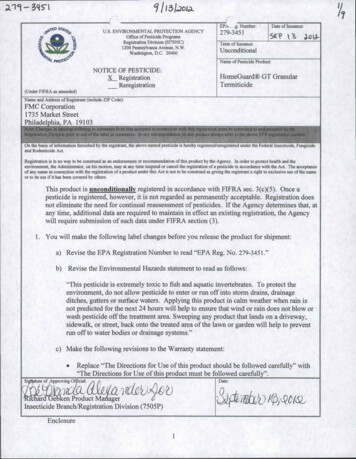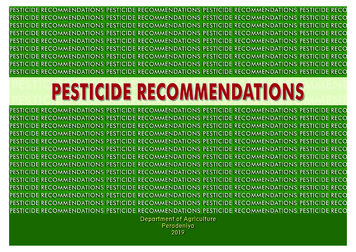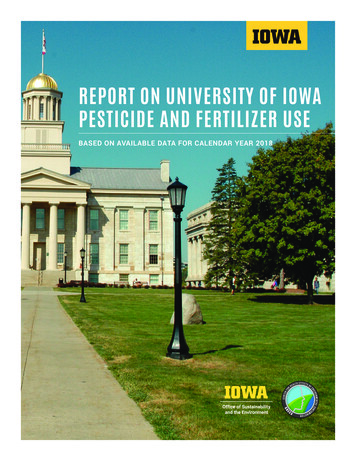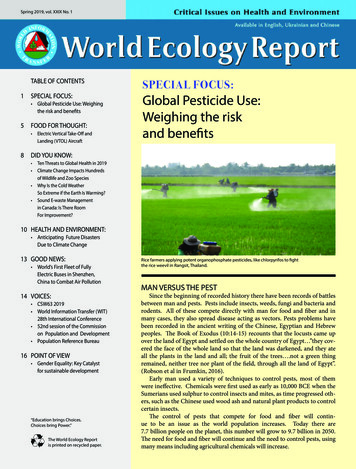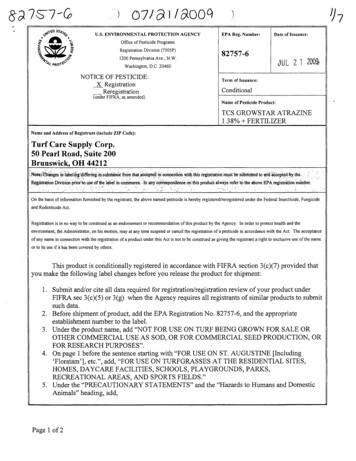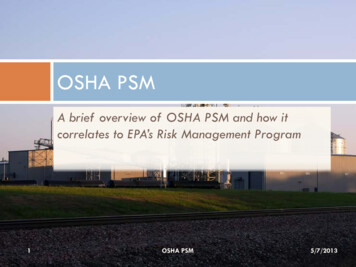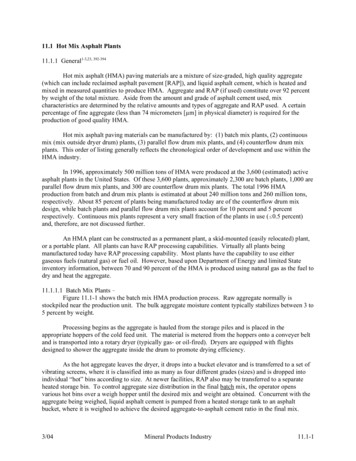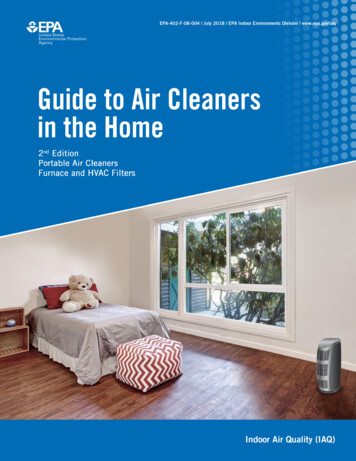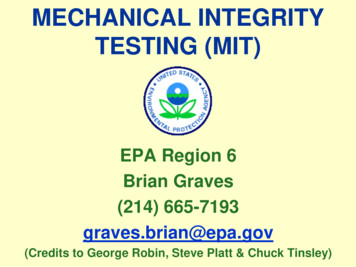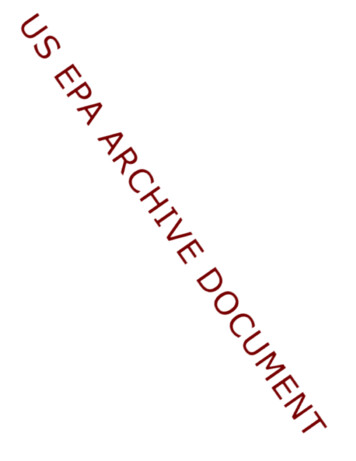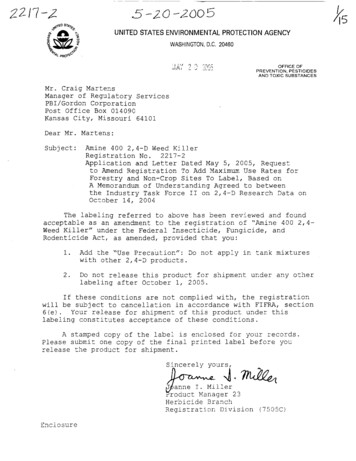
Transcription
22/7-.2.5 -20-200 UNITED STATES ENVIRONMENTAL PROTECTION AGENCYWASHINGTON, D.C. 20460;'·,'1AIt 2 :J ;''YI:':;OFFICE OFPREVENTION, PESTICIDESAND TOXIC SUBSTANCES\., v ,,'Mr. Craig MartensManager of Regulatory ServicesPBI/Gordon CorporationPost Office Box 014090Kansas City, Missouri 64101Dear Mr. Martens:Subject:Amine 400 2,4-D Weed KillerRegistration No.2217-2Application and Letter Dated May 5, 2005, Requestto Amend Registration To Add Maximum Use Rates forForestry and Non-Crop Sites To Label, Based onA Memorandum of Understanding Agreed to betweenthe Industry Task Force lIon 2,4-D Research Data onOctober 14, 2004The labeling referred to above has been reviewed and foundacceptable as an amendment to the registration of "Amine 400 2,4Weed Killer" under the Federal Insecti ide, Fungicide, andRodenticide Act, as amended, provided that you:1.Add the "Use Precaution": Do not apply in tank mixtureswith other 2,4-D products.2.Do not release this product for shipment under any otherlabeling after October 1, 2005.If these conditions are not complied with, the registrationwill be subject to cancellation in accordance with FIFRA, section6(e).Your release for shipment of this product under thislabeling constitutes acceptance of these conditions.A stamped copy of the label is enclosed for your records.Please submit one copy of the final printed label before yourelease the product for shipment.Sincerely yours, anne I. Millerroduct Manager 23Herbicide BranchRegistration Division (7505C)Enclosure
AMINE 400 2,4-D WEED KILLERACTIVE INGREDIENT:Dimethylarnine salt of 2.4-dichlorophenoxyacetic acid . .INERT INGREDIENTS: . .TOTALThis product contains:3.81bs. of2.4-dichlorophenoxyacetic acid equivalent per gallon or 38.6%Isomer Specific by AOAC Methods.46.4%53.6%100.0%ACCEPTEDwith COMMENTSIn EPA Letter Dated:MAY 2 0 20nsKEEP OUT OF REACH OF CHILDRENIJnder the FedcralInsOCtfcTde.Funglcidd, 8111 RDdC2IIlcide Iv:J.85 amerwt'" tbr tile pesdddcregIsIaaI UIIIIer EPA Reg. No.d-'d l1-d-.DANGER-PELIGROSi Usted no entiende la etiqueta, busque a alguien para que se la explique a Usted endetalle. (If you do not understand the label, find some one to explain it to you in detail.)See Precautionary Statements and First Aid elsewhere on this label.NET CONTENTS: 1.0 Quart, 1.0 Gallon, 2.5 Gallons,30,55 and 275 Gallons814/ APxxxxxxEPA REG. NO. 2217-002EPA EST. NO. 2217-KS-lMANUFACTURED BY@)! :4% SFFHAD .l:impk yer-OwJJ«l .217 We , . SI ."KA""". City. MI .,,, "".0.Telephone: 1·800-821'7925Page 1 of 14EPA Reg. No. 2217-002
3 /(5READ THE ENTIRE LABEL FIRST. OBSERVE ALL PRECAUTIONSAND FOLLOW DIRECTIONS CAREFULLY.PRECAUTIONARY STATEMENTSHazards to Humans and Domestic AnimalsDANGER: Corrosive. Causes irreversible eye damage. Causes skin irritation. Do not get in eyes, on skinor clothing. This product is harmful or fatal if swallowed.Personal Protective Equipment (PPE):Applicators and other handlers must wear long-sleeved shirt and long pants, waterproof gloves, shoesplus socks, and protective eyewear.Discard clothing and other absorbent materials that have been drenched or heavily contaminated with thisproduct's concentrate. Do not reuse them. Follow manufacturer's instructions for cleaning/maintainingPPE. If no such instructions for washables, use detergent and hot water. Keep and wash PPE separatelyfrom other laundry.Engineering Control Statements:Containers greater than 1 gallon and less than 5 gallons: Mixers and loaders who do not use a mechanicalsystem (probe and pump) to transfer the contents of this container must wear coveralls or a chemicalresistant apron in addition to the other required PPE.Containers of 5 gallons or more: Do not open-pour product from this container. A mechanical system(such as a probe and pump or spigot) must be used for transferring the contents of this container. If thecontents of a non-refillable pesticide container are emptied, the probe must be rinsed before removal. Ifthe mechanical system is used in a manner that meets the requirements listed in the Worker ProtectionStandard (WPS) for agricultural pesticides [40 CFR 170.240(d)(4)], the handler PPE requirements may bereduced or modified as specified in the WPS.When handlers use enclosed cabs or aircraft in a manner that meets the requirements listed in theWorker Protection Standard (WPS) for agricultural pesticides [40 CFR 170.240(d)(4-6)], the handler PPEreQuirements may be reduced or modified as specified in the WPS.User Safety Recommendations:Users should: Wash hands before eating, drinking, chewing gum, using tobacco or using the toilet. Remove clothing immediately if pesticide gets inside. Then wash thoroughly and put on cleanclothing. Remove PPE immediately after handling this product. Wash the outside of gloves before removing.As soon as possible, wash thoroughly and change into clean clothing.First AidHold eye open and rinse slowly and gently with water for 15-20 minutes.0 Remove contact lenses, if present, after the first 5 minutes, then continue rinsingeye.o Call a poison control center or doctor for treatment advice.o Take off contaminated clothing.If on skin:o Rinse skin immediately with plenty of water for 15 - 20 minutes.0 Call a poison control center or doClor for treatment advice.o all a poison control center or doClor immediately for treatment advice.If swallowedo Have person sip a Illass of water if able to swallow.o Do not induce vomiting unless told to do so by the pOison control center or doctor.o Do not oive anvthino bv mouth to an unconscIous person.o Move person to fresh air.If Inhaled:0 If person is not breathing, call 911or an ambulance, then give artificialrespiration, preferably mouth-to-mouth if possible.o Call a poison control center or doctor for treatment advice.Have the product container or label with you when calling a poison control center or doctor or going fortreatment. You may also contact 1-877-800-5556 for emergency medical treatment advice.If In eyes:oNOTE TO PHYSICIAN: Probable mucosal damage may contraindicate the use of gastric lavage.Page 2 Qf 14EPA Reg. No. 2217-002
ENVIRONMENTAL HAZARDS:Do not apply when weather conditions favor drift from target area. Do not contaminate domestic orirrigation waters.This product is toxic to aquatic invertebrates. Drift or runoff may adversely affect aquatic invertebrates andnontarget plants. For terrestrial uses, do not apply directly to water, or to areas where surface water ispresent, or to intertidal areas below the mean high water mark. Do not contaminate water when disposingof equipment washwater.Most cases of groundwater contamination involving phenoxy herbicides such as 2,4-D have beenassociated with mixinglloading and disposal sites. Caution should be exercised when handling 2,4-Dpesticides at such sites to prevent contamination of groundwater supplies. Use of closed systems formixing or transferring this pesticide will reduce the probability of spills. Placement of the mixinglloadingequipment on an impervious pad to contain spills will help prevent groundwater contamination.DIRECTIONS FOR USEIt is a violation of Federal law to use this product in a manner inconsistent with its labeling.Do not apply this product in a way that will contact workers or other persons, either directly or through drift.Only protected handlers may be in the area during application.For any requirements specific to your State or Tribe, consult the agency responsible for pesticideregulation.AGRICULTURAL USE REQUIREMENTSUse this product only in accordance with its labeling and with the Worker Protection Standard, 40 CFRpart 170.This standard contains requirements for the protection of agricultural workers on farms, forests,nurseries, and greenhouses, and handlers of agricultural pesticides. It contains requirements fortraining, decontamination, notification, and emergency assistance. It also contains specific instructionsand exceptions pertaining to the statements on this label about personal protective equipment andrestricted-entry interval. The requirements in this box only apply to uses of this product that are coveredby the Worker Protection Standard.Do not enter or allow worker entry into treated areas during the restricted-entry interval (REI) of 48hours.For early entry to treated areas that is permitted under the Worker Protection Standard and thatinvolves contact with anything that has been treated, such as plants, soil, or water, wear: coveralls,waterproof gloves, shoes plus socks, and protective eyewear.STORAGE & DISPOSALDo not contaminate water, food, or feed by storage or disposal.PESTICIDE STORAGE: Store in original container in a locked storage area inaccessible to children orpets. Keep from freezing.PESTICIDE DISPOSAL: Pesticide wastes are acutely hazardous. Improper disposal of excess pesticide,spray mixture, or rinsate is a violation of Federal law and may contaminate groundwater. If these wastescannot be disposed of by use according to label instructions, contact your state Pesticide or EnvironmentalControl Agency or the Hazardous Waste representative at the nearest EPA Regional Office for guidance.CONTAINER DISPOSAL: For Plastic Containers - Triple rinse (or equivalent). Then offer for recycling orreconditioning, or puncture and dispose of in a sanitary landfill, or incineration, or if allowed by state andlocal authorities by burning. If burned stay out of smoke. For Metal Containers - Triple rinse (orequivalent). Then offer for reCYCling or reconditioning, or puncture and dispose of in a sanitary landfill, orby other procedures approved by state and local authorities.Page 3 of 14EPA Reg. No. 2217-002
5/./15USE PRECAUTIONS:Do not apply this product through any type of irrigation system.Do not overdosel Avoid spray drift to cotton, soybeans, tomatoes, tobacco, grapes, fruit trees, flowers,garden crops, ornamental plants, shrubs, trees and other sensitive plants. Do not apply near these plantssince small quantities of wind drifted herbicide may cause severe injury.Do not apply when wind speed is sufficient to cause drift. Do not apply when an air temperature inversionexists. An inversion may be detected by creating a smoke column and observing a layering effect.Do not apply when temperatures exceed 90'F and humidity is high.To aid in avoiding spray drift, use coarse sprays and low pressure. Do not use nozzles which produce finespray droplets under high pressure. The use of thickening agents or antidrift additives and drift reducingequipment is of value in preventing spray drift. Care should be taken not to make applications whererunoff could carry the chemical to nontarget areas. Local spray conditions will vary. Check localrecommendations first WEEDS CONTROLLED·Annual and Biennial Weeds:BeggarticksBitterweedBroomweedBull offeeweedCrotonDevil's clawFleabane artersLettuce (wild)MallowMarshelderMarijuanaMorningglory (annual)Musk rickly lettucePrimrosePuncturevineRadish (wild)Ragweed (common)Russian thistleShepherds purseSmartweedSneezeweedSowthistle (common)Spanish d carrotWild parsnipWitchweedWormwoodYellow starthistleGoldenrodGround ivyHealallHoary cressHorsetailIronweedLocoweedNettleOrange hawkweedPlantainPovertyweedRushesSouthern wild roseSowthistleStinging nettleStrawberry (wild)Tall buttercupTanweedToadflaxVervainYellow rocketWild garlicWild onionWild sweet potatoPerennial Weeds:ArtichokeAsterAustrian fieldcressBindweedBlackeyed SusanBlue lettuceCanada thistleCatnipChicoryClover (many types)DandelionDockDogbanePage 4 of 14EPA Reg. No. 2217-002
FOR USE IN SMALL GRAINSCropsDosage Rate, Spray Volume,PlntsiAcreGallonsiAcreWheat, Barley,Rye, Oats,Winter grains:Annual andbiennial weeds.'h to 2"8 or morePerennialbroad leaf weeds1 to 2"8 or moreSpring grains:Annual broad leafweedsPerennialbroad leaf weeds'h to 2"8 or more1 to 2"8 or moreInstructionsApply after crop is fully tillered (about 4" to 8"high) and before jointing.Oats are moresensitive to 2,4-0 than other crops and should besprayed in spring when well established andtillered and before jointing; (use 'h to 1 pint peracre). Do not spray crop in boot to dough stage.Apply when weeds are near bud stage. Do notspray crop in boot to dough stage.Apply after crop is fully tillered (about 4" to 8"high) and before jointing. Do not spray crop inboot to dough stage.Apply when weeds are near bud stage. Do notspray crop in boot to dough stage."Notes About The Above:Use the lower rate if small annual and biennial weeds are the major problems. Use the higher rate ifweeds present are in the hard-to-control categories as determined by local experience. The higherrates increase the risk of crop injury and should be used only where the weed control problem justifiesthe crop damage risk.Do not forage or graze treated grain fields within 2 weeks after treatment.For Aerial Applications on Cereal Grains - Spray volumes of 3 to 10 gallons of water per acre areappropriate.FOR EMERGENCY WEED CONTROL IN WHEATPerennial Broadleaf Weeds: Apply 3 pints of product per acre when weeds are approaching bud stage.but do not spray grain in the boot to dough stage. The application rate of 3 pints of product (1.5 lb. acidequivalent) per acre can produce injury to wheat. Balance the severity of your weed problem against thepossibility of crop damage. Where perennial weeds are scattered. spot treatment is suggested tominimize the extent of crop injury. Do not feed treated straw to livestock.FOR USE IN ROW CROPS, PASTURES AND RANGELANDSCropsDosage Rate, Spray Volume,PlntsiAcreGallonslAcreInstructionsCORN (Field & Sweet)PreemergencePostem ergenceannual broadleafweeds2 to 3'h to 115 to 308 to 15Apply just before corn emerges.Apply when most weeds have germinated. Cornis susceptible to injury at time of emergence andshortly after unfolding of leaves. Do not sprayduring this period. Do not spray corn during thetassel to hard dough stages. Use drop nozzleswhen corn is 10" tall to place spray below itsleaves. Do not cultivate soon after spraying whilecorn is brittle. Do not forage or feed fodder for 7days following application.CONTINUED .Page 5 of 14EPA Reg. No. 2217-002
7Dosage Rate, Spray af weedsJ(SInstructions1 to 1%8 to 15Apply when weeds are in bud to bloom stage. Usedrop nozzles after com is 10" tall. Do not spraycorn during the tassel to hard dough slages. 2,4-0may cause brittleness to corn. Winds or cuttivalionmay cause stalk breakage while brittle. Certainsingle cross corn hybrids may be more susceptibleto 2,4-0 injury than others.16 to 10Apply when sorghum is 4' to 12" tall. Use dropnozzles to keep spray off sorghum plants, whensorghum is over 10' tall. Do not forage or feedfodder for 7 days following application.1% to 2%5 to 10To control curly indigo and other broadleaf weeds,apply 7 to 10 weeks after planting when rice is fullytillered. Do not spray rice in boot stage.Preemergence415 to 20Postemergence1% to 210 to 30Apply before canes appear for control of emergedbroadleaf weeds.Apply after cane emerges and through lay-by.GRAIN SORGHUMPostemergenceRICESUGARCANERANGELAND, PASTURE AND TURF AREASGolf Courses,Parks,Cemeteries(Do not use ongolf greens noron dichondra orother broad leafherbaceousgroundcovers.)2 to 4"3to 60Use the lower rate if annual and biennial weedsare the major problem. The maximum applicationrate to pasture and rangeland is 2 pounds 2,4-0acid equivalent per acre per application per Site.Do not apply to newly seeded turf until grass hasbeen cut several times. Where bentgrasspredominates, make 2 applications of 1 pint ofproduct per acre at 3 week intervals. Do not useon susceptible southern grasses such as 5t.Augustinegrass, bentgrass, and dichondra; clovermay be injured by this treatment. Observe thefollowing intervals:a) A 7 -day grazing interval after treatment for dairycattle.a) A 30-day preharvest interval for grass cut forhay; &a) A pres laughter interval for meat animals of 3days.'Use 2 or more gallons of water per acre for aerial applications.To convert local recommendations into terms of Amine 400 2,4-0 Weed Killer use the following table.2,4-0 Acid Equivalent1 lb.I'lIIlb.I% lb.I'!alb.I14 lb.I'/.Ib.I'I, lb.1 pintI'lII pintI% pintI'I. pintI14 pintAmine 400 2,4-0 Weed Killer2 pintsI1% pintsIPage 6 of 14EPA Reg. No. 2217-002
FOR USE IN REDUCED OR NO-TILLAGE SOYBEANS (Preplant Only)- GENERAL INFORMATION Amine 400 2,4-D Weed Killer is a phenoxy type herbicide that provides postemergence control of manysusceptible annual and perennial broad leaf weeds. Amine 400 2,4-D Weed Killer may be applied prior toplanting soybeans to provide foliar burndown control of susceptible annual and perennial broadleaf weedsand certain broad leaf cover crops such as those listed on this label. Amine 400 2,4-D Weed Killer shouldonly be applied preplant to soybeans in situations such as reduced tillage production systems, whereemerged weeds are present. Apply only according to the application instructions given below.- MIXING INSTRUCTIONS Mix Amine 400 2,4-D Weed Killer only with water, unless otherwise directed on this label. Compatiblecrop oil concentrates, agricultural surfactants and fluid fertilizers approved for use on growing crops mayincrease the herbicidal effectiveness of 2,4-D on certain weeds and may be added to the spray tank.Read and follow all directions and precautions on this label and on all labels of adjuvants or fertilizersmixed with this product.- APPLICATION PROCEDURES Apply using air or ground equipment in sufficient gallonage to obtain adequate coverage of weeds. Use 2or more gallons of water per acre in aerial equipment and 10 or more gallons of water per acre in groundequipment.APPLICATION TIMING AND USE RATES FOR AMINE SALTSMaximum Amount ofAmine 400 to Apply/AcreMaximum Rate(Pounds 2.4-D a.eJAcre)When to Apply(Days Prior To Planting Soybeans)1 Pint0.5Not Less Than 15 Days1 Quart1.0Not Less Than 30 DaysWEEDS CONTROLLEDAlfalfa'Bindweed'BullnettleBittercress, smallfloweredButtercup, smallfloweredCarolina geraniumCinquefoil, common and roughClover, red'Cocklebur, commonDandelionDock, curly'Eveningprimrose, cutleafGarlic, wild'Horseweed or MarestailIronweedLambsquarters, commonLettuce, pricklyMorningglory, annualMousetailMustard, wildOnion, wild'Pennycress, fieldPlantainPurslane, commonRagweed, commonRagweed, giantShepherdspurseSmartweed, PennsylvaniaSowthistle, annualSpeedwellThistle, Canada'Thistle, bullVelvetleafVetch, hairy'Virginia copperleaf'These species are only partially controlled.In general, weeds should be small, actively growing and free of stress caused by extremes in climaticconditions, diseases, or insect damage at the time of treatment. The response of individual weed species10 Amine 400 2,4-D Weed Killer is variable. Consult your local county or State Agricultural ExtensionService or crop consultant for advice.Page 7 of 14EPA Reg. No. 2217-002
APPLICATION RESTRICTIONS AND PRECAUTIONS FOR SOYBEANS (PREPLANT ONLY) Important Notice: Unacceptable injury to soybeans planted in fields previously treated with Amine 4002,4-D Weed Killer may occur. Whether or not soybean injury occurs and the extent of the injury willdepend on weather (temperature and rainfall) from herbicide application until soybean emergence andagronomic factors such as the amount of weed vegetation and previous crop residue present. Injury ismore likely under cool rainy conditions and where there is less weed vegetation and crop residue present.Apply a maximum of one application per growing season regardless of the treatment rate.Do not apply Amine 400 2,4-D Weed Killer when weather conditions such as air temper
May 20, 2005 · Registration No. 2217-2 Application and Letter Dated May 5, 2005, Request to Amend Registration To Add Maximum Use Rates for Forestry and Non-Crop Sites To Label, Based on A Memorandum of Understanding Agreed to between the Industry Task Force
